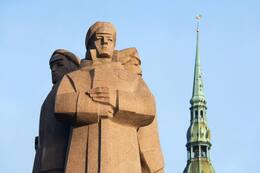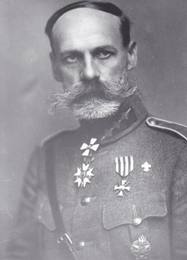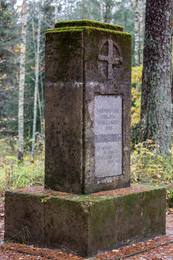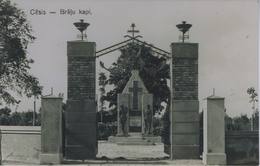Latvijos raudonieji šauliai
I WW1, I Nepriklausomybės karai

Terminas „raudonieji šauliai“ atsirado per Rusijos pilietinį karą 1918 m., siejant Latvijos šaulių dalinius su „raudonąja gvardija“, Rusijos „raudonąja armija“ ir apibendrintu terminu „raudonieji“, kuris buvo taikomas bolševikų (vėliau komunistų) šalininkams.
Prasidėjus Pirmajam pasauliniam karui, Latvijos teritoriją palaipsniui okupavo vokiečių kariuomenė, prasidėjo didelis pabėgėlių judėjimas. 1915 m. vasarą Rusijos armija patyrė didelių pralaimėjimų, o Kuršas, Žiemgalė ir dalis Sėlijos pateko į vokiečių okupaciją. Latvijos iniciatyva formuoti nacionalinius dalinius buvo vienas iš nedaugelio šiaudų, už kurių galėjo laikytis Rusijos armija, persekiojama savo nesėkmių. 1915 m. rugpjūčio 10 d. spaudoje buvo paskelbtas rašytojų K. Skalbės ir A. Ķeninio parašytas, o Rusijos Valstybės Dūmos deputatų Jānio Goldmanio ir Jānio Zālīčio pasirašytas kreipimasis į Latvijos žmones formuoti nacionalinius karinius dalinius. Iš viso prašymus pateikė apie 8000 savanorių, o per visą Pirmąjį pasaulinį karą Latvijos šaulių batalionuose tarnavo iki 25 000 vyrų.
1917 metais bolševizmo idėjos sparčiai plito tarp karo į neviltį varomų latvių. Bolševikų šūkiai apie taiką, žemę ir duoną buvo labai populiarūs karo išvargintoje Latvijos visuomenėje. Bolševikų įtaka augo ir tarp šaulių, kurie ankstesnėse žiemos kovose patyrė beprasmių ir didelių nuostolių.
1917 m. rudenį vokiečiai, pasinaudodami Rusijos armijos kovinių pajėgumų sumažėjimu, užėmė Rygą, o 1918 m. vasarį – visą Vidžemę ir Latgalą. Didelė dalis šaulių pasidavė vokiečiams arba tiesiog dezertyravo iš savo dalinių ir liko Vidžemėje. Bajorai ir ištikimiausia šaulių dalis pabėgo į Rusiją. 1918 m. balandžio 13 d. Maskvoje buvo suformuota Latvijos šaulių sovietinė divizija.
Latvijos raudonųjų šaulių daliniai buvo naudojami Rusijos sovietų vyriausybei ir aukštiems pareigūnams, užsienio šalių ambasadoms ginti, palaikyti tvarką didžiausiuose Rusijos miestuose, malšinti valstiečių ir darbininkų sukilimus ir kovoti su bolševikų politiniais oponentais per Rusijos pilietinį karą nuo 1918 iki 1920 metų.
Pasirašius taikos sutartį tarp Rusijos ir Latvijos, 1921 m. vasarą iš Sovietų Rusijos grįžo 11 395 buvę „raudonieji“ Latvijos šauliai. Dalis vadovybės liko Sovietų Rusijoje ir sėkmingai darė karinę karjerą. Dauguma buvusių šaulių žuvo per didžiąsias Stalino represijas 1937–1938 m.
Daugiau informacijos šaltinių
1. Sielų pūga. Skaitmeninis muziejus. Prieinama: https://www.dveseluputenis.lv/lv/laika-skala/notikums/93/1917.-gads--latvijas-neatkaribas-cela-sakums/, https://www.dveseluputenis.lv/lv/laika-skala/notikums/128/strelnieki-atgriezas-majup-no-krievijas/ [žiūrėta: 2021-05-08].
2. Šiliņš J. „Latvių raudonieji šauliai“. Nacionalinė enciklopedija. Prieinama: https://enciklopedija.lv/skirklis/36374-latviešu-sarkanie-strēlnieki [žiūrėta 2021-05-08].
3. Vējiņš J. Latvija - likimo vagoje 1918 - 1991, Spaudos rūmai, 2007 m.
Susijusi laiko juosta
Susijusios vietos
Latvijos šaulių paminklas Rygoje
Įsikūręs Rygos centre, Latvijos šaulių aikštėje, netoli Latvijos okupacijos muziejaus.
Latvijos šaulių paminklas buvo atidengtas 1971 m. Latvijos šaulių aikštėje, šalia buvusio Latvijos raudonųjų šaulių muziejaus (dabar Okupacijos muziejus). Sovietmečiu į šią temą buvo žiūrima per siaurą komunistinio režimo ideologinę prizmę. Ši vieta tarnavo kaip Rygos reprezentacija ir idealizuoto pasakojimo kūrimas, sustiprinant mitą apie latvius kaip kovotojus už sovietų valdžią.
Rusijos armijos lengvieji pėstininkų daliniai buvo vadinami šauliais. Pirmojo pasaulinio karo metu Latvijos šaulių junginiai buvo kuriami kovai su Vokietijos armija tėvynėje. Tai buvo motyvuoti, pavojingi ir drausmingi koviniai daliniai. Aukštas išsilavinimo lygis ir vokiečių kalbos žinios buvo naudingos žvalgybai ir netikėtų atakų vykdymui. Žlugus Rusijos imperijai ir Vokietijai visiškai okupavus Latvijos teritoriją, labai daug Latvijos gyventojų atsidūrė Rusijoje, kur toliau susidūrė su bolševikų agitacija. Iš pradžių palaikymas Lenino idėjoms ir dalyvavimas Rusijos pilietiniame kare augo. Vėliau kilo nusivylimas, ir dauguma Latvijos kareivių nusisuko nuo kairiųjų idėjų ir grįžo į Latviją. Dauguma Rusijoje likusių kareivių žuvo per „Stalino valymus“ (1936–1938 m.). Latvijos šauliai labai prisidėjo prie Latvijos valstybės ir jos kariuomenės kūrimo.
Šiandien galite aplankyti paminklą ir gretimą Okupacijos muziejų.
Generolo Karlso Gopperso atminimo kambarys jo gimtinėje „Maskati“
Įsikūręs Plani valsčiuje, ant Vijos upės kranto.
Galima aplankyti generolo Kārlio Gopperso atminimo kambarį jo gimtinėje „Maskati“.
„Maskatu“ ūkį valdė generolo brolis Augustas Goppersas, nes talentingas karo vadas buvo užsiėmęs svarbiais įvykiais ir pasauliniais karais. 1920 m. generolas grįžo į Latviją, į gimtuosius namus. Tačiau daugelis atsakingų pareigų jį siejo su Ryga. Augustas toliau vadovavo „Maskatu“. 1940 m. generolas Goppersas buvo suimtas ir 1941 m. kovo 25 d. sušaudytas Čekos rūsiuose. 1944 m. Gopperių šeima su trimis arklių traukiamomis vežimais pabėgo į Kuršą. Karas išskyrė šeimą, o Aleksandro Gopperso dukros – Biruta, Elza ir Ana – liko Latvijoje. Joms nebebuvo leista grįžti į „Maskatu“. Namai buvo dideli ir kruopščiai prižiūrimi. Juose atskiruose kambariuose buvo apgyvendintos trys ar keturios naujokų šeimos. Dideliame tvarte buvo įrengtas arklių ferma. Dėl tarpusavio kivirčų 1980 m. kilo gaisras. Sudegė tvartas ir didelis sandėlis. Laimei, ugnis į namą nepersimetė, liepsnas atbaidė dideli mūsų protėvių sodinti medžiai.
1991 m., po stebuklingo Atgimimo, Latvijos valstybė atgimė antrą kartą. 1992 m. generolo Gopperso brolio Augusto šeima susigrąžino „Maskatus“ kaip savo protėvių šventą vietą. Dešimt metų visi sunkiai dirbo, kad išgelbėtų namus nuo sunaikinimo, atkurtų ir atstatytų sugriautus pastatus, kad visas „Maskatus“ ūkis būtų gražus. Namai buvo atkurti iki senovinės išvaizdos, taip pat įrengtas generolo Kārlio Gopperso atminimo kambarys. Atminimo kambarį galima aplankyti iš anksto paskambinus ir susitarus telefonu +371 29396870, +371 29254285.
Ekskursija prie paminklo Pirmajame pasauliniame kare žuvusiems kariams Spārės dvaro parke
Įsikūręs Spārės dvaro komplekso teritorijoje.
Pirmojo pasaulinio karo metu Spārės dvare buvo įrengta Rusijos armijos lauko ligoninė. Netoliese esančiose brolijos kapinėse palaidoti 24 ten žuvę kareiviai, tarp jų ir latvių šauliai. Paminklas atidengtas 1935 m. spalio 6 d.
Įrengiant memorialinę vietą (pradedant nuo kelio), abiejose kelio pusėse buvo pasodintos liepų eilės. 1935 m. visus teritorijos tvarkymo darbus atliko Spārės mokiniai, vadovaujami mokyklos direktoriaus Kārlio ir Alvīnės Skalbergų.
Atminimo vietos tvarkymo darbuose taip pat dalyvauja Amatos savivaldybės Spārės pradinės mokyklos mokiniai. Šiuose darbuose didelę paramą teikia Cėsių 27-oji kryžminė gvardija.
Tradicija tapo fakelų eisena į Pirmajame pasauliniame kare žuvusiųjų atminimo vietą, organizuojama lapkričio 11 d. Šiam renginiui visada vadovauja Cėsių 27-osios kryžminės gvardijos rinktinės nacionalinės gvardijos būrys, o juos visada lydi kapelionas. Neabejotina renginio dalis – šventinė salvė.
Spārės dvaro komplekso teritorijoje siūloma ekskursija į paminklą Pirmajame pasauliniame kare žuvusiems kariams (45 min.), iš anksto užsiregistravus telefonu +371 26558464.
Paminklas Pirmajame pasauliniame kare ir Latvijos nepriklausomybės kare žuvusiems kariams
Įsikūręs Bažnyčios gatvėje priešais Šv. Onos bažnyčią.
Galima pamatyti paminklą Pirmajame pasauliniame kare ir Latvijos Nepriklausomybės kare žuvusiems kariams.
1923 m. gegužės 1 d. priešais Mazsalacos liuteronų bažnyčią buvo pasodinta „Didvyrių giraitė“, kurioje kiekvienam žuvusiam kareiviui buvo skirtas ąžuolas. Pasak Likerto, iš viso buvo pasodinti 97 ąžuolai – 23 žuvusiems Nepriklausomybės kare ir 74 žuvusiems Pirmajame pasauliniame kare. Tačiau to meto spaudoje buvo minima, kad buvo pasodinti 106 ąžuolai.
1927 m. rugpjūčio 21 d. „Didvyrių giraitėje“ buvo atidengtas architekto Paulo Kundzinio suprojektuotas betoninis paminklas, kurio statyboje dalyvavo ir skulptorius Vilhelmas Treijsas.
Paminklas yra šalia Mazsalacos Šv. Onos bažnyčios, kuri buvo pastatyta specialiai parinktoje vietoje, kad jos lieknas (58,6 m), gražus bokštas būtų matomas iš tolo. Bažnyčia yra gerai išsilaikiusi, nes sovietmečiu nebuvo nei sunaikinta, nei pritaikyta jokiems kitiems tikslams.
Cėsių brolių kapinės
Įsikūręs Cėsių Žemutinėse kapinėse, Lenču g. 15, Cėsis.
Viena reikšmingiausių Pirmojo pasaulinio karo ir Nepriklausomybės kovų memorialinių vietų Cėsyje yra Brolių kapinės Lejos Kapuose.
Kapinėse yra Cėsių menininko ir tarybos nario Augusto Jullos (1872–1958) suprojektuotas, 1927 m. atidengtas Brolių kapinių paminklas, skirtas 1915–1920 m. Brolių kapinėse palaidotiems kariams.
Cėsių Lėjos kapinių Brolių kapuose palaidota apie 200 kareivių. Tarp jų yra nežinomas skaičius Latvijos šaulių ir rusų kareivių, žuvusių Pirmajame pasauliniame kare, taip pat vokiečių (10), lenkų ir kitų tautybių kareivių. Latvijos išsivadavimo kovų metu šiose kapinėse palaidoti 22 5-ojo (2-ojo) Cėsių pėstininkų pulko kareiviai, taip pat 11 laisvės kovotojų, žuvusių kituose Latvijos armijos daliniuose. Brolių kapuose taip pat ilsisi 2 estai, 15 bolševikų aukų ir Latvijos raudonieji šauliai.
Kračių kalnų paminklas
Krāčių kalnynas yra viena didžiausių Litorinos jūros pakrantės kopų. Aukščiausias jos taškas yra 29 m virš jūros lygio ir 26 m virš aplinkinių lygumų. Sakoma, kad Litorinos jūra yra Baltijos jūros, egzistavusios maždaug prieš 7000–5000 metų, pirmtakė.
12-osios Rusijos armijos 6-oji specialioji brigada Kalėdų mūšių metu pradėjo puolimą nuo Krāčių kalvų, turėdama užduotį pralaužti vokiečių frontą nuo Didžiosios Tyrelių pelkės iki Lielupės upės. Per mėnesį trukusius mūšius Rusijos armija užėmė 25 kvadratinių kilometrų plotą, tačiau nuostoliai buvo milžiniški – 45 tūkstančiai žuvusių, sužeistų ir dingusių be žinios kareivių. Latvijos šaulių nuostoliai siekė 9 tūkstančius žuvusių, sužeistų ir dingusių be žinios kareivių. Kalėdų mūšių metu Latvijos šauliai pelnė didžiulę didvyriškų ir šaunių kareivių šlovę, sumokėdami už tai labai didelę kainą – savo gyvybes.
Žuvusiųjų mūšyje atminimui pastatytas paminklas. Kiekvienais metais lapkričio 11 d., Lačplėsio dieną, ir lapkričio 18 d., Latvijos valstybės paskelbimo metines, šioje vietoje uždegamos žvakės žuvusiems didvyriams atminti.
Saugoma gamtos teritorija „Krāčių kalnai“ kaip Litorinos laikotarpio kopų kalva
Susijusi istorija
Anšlavo Eglīčio prisiminimai apie Latvijos nepriklausomybės karą ir 1919 m. įvykius Alūksnėje
1919 m. kovo 27 d. 1-asis Valmieros pėstininkų pulkas kartu su Talino (tuometinio Rėvelės) ir Tērbato Estijos gvardijos (kaitselit) batalionais bei trimis šarvuočiais traukiniais pradėjo Latvijos išlaisvinimą nuo bolševikų nuo Melnupės upės krantų.
Apie generolą Karlį Goppersą
Generolas K. Goppersas (1876–1941) buvo iškilus kareivis ir iškili asmenybė. Jis pasižymėjo kaip sėkmingas vadas, vadovavęs batalionams ir pulkams, didvyriškai vadovavęs savo šauliams kovose už Latvijos laisvę Pirmojo pasaulinio karo (1914–1919 m.) metu. Jis dalyvavo mūšiuose prie Tyreļpurvos, Ložmetējkalno ir ginant Rygą.
Karo muziejaus kūrimo pradžios prisiminimai
Pasakotojas aprašo aplinkybes, kuriomis buvo įkurtas Karo muziejus. Paminėtos problemos ir kolekcijų kūrimo darbai.
Gelbėtas tiltas per Negos upę nuo sprogdinimo
1944 m., vokiečiams traukiantis, buvo susprogdinta daug svarbių objektų ir to išvengti buvo labai sunku, tačiau pasakojama ir apie stebuklingus atvejus, kai vietos gyventojų drąsa ir kareivio tolerancija leido išsaugoti vietos gyventojams svarbias vietas, o lašišos išgyveno. Viena iš istorijų – apie namų šeimininkės ir vokiečių kareivio pokalbį, kuris išgelbėjo visą tiltą nuo susprogdinimo.











